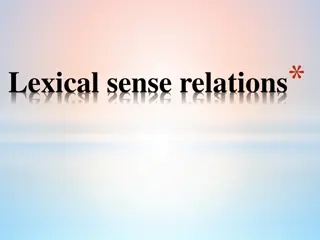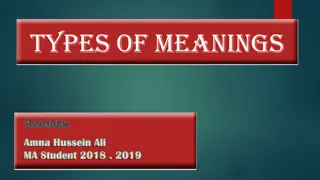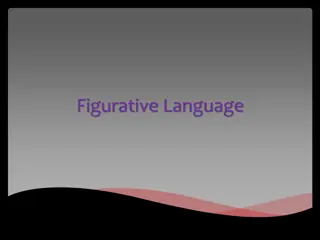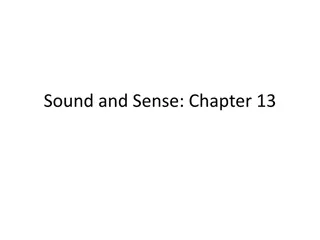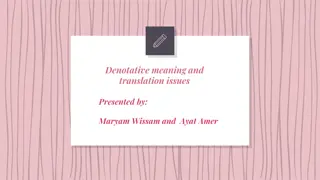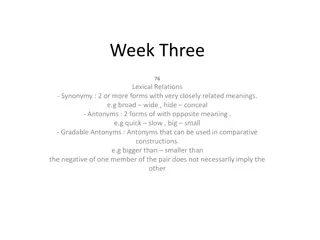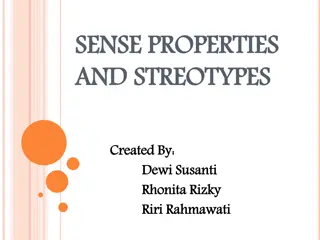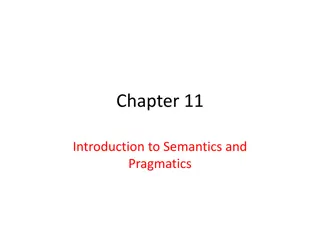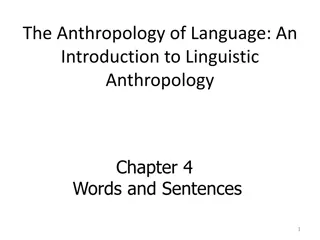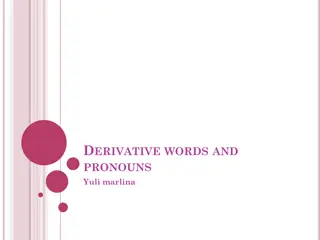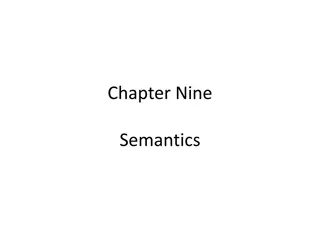Understanding Words: Forms and Meanings in Language
Linguists explore the relationship between form and meaning in words, acknowledging that one form can have multiple meanings and vice versa. Different notational conventions are used to distinguish between form, meaning, and the word itself, emphasizing the importance of understanding how words function in language.
Download Presentation

Please find below an Image/Link to download the presentation.
The content on the website is provided AS IS for your information and personal use only. It may not be sold, licensed, or shared on other websites without obtaining consent from the author. Download presentation by click this link. If you encounter any issues during the download, it is possible that the publisher has removed the file from their server.
E N D
Presentation Transcript
WORDS FORMS & MEANING TRANSPARENT & OPAQUE
FORMS & MEANING One of the assumptions with which linguists have been operating so far and which may now be made explicit is that words have meaning as well as form. Lyons (1995) stated that one form word may have more than one meaning ( head, chief, leader , start, top) and vice versa , different forms may indicate the same meaning ( happy , cheerful, glad )
In any language, not only English, which is associated with a writing-system, whether alphabetic or non- alphabetic, words have both a spoken form and a conventionally accepted written form. In certain cases, the same spoken language is associated with different writing-systems, so that the same spoken word may have several different written forms. Conversely phonologically distinct spoken languages may be associated, not only with the same writing- system, but with the same written language, provided that, as is the case with the so-called dialects of Modern Chinese, there is a sufficient degree of grammatical and lexical isomorphism among the different spoken languages
Lyons main concern was how to distinguish the word from both its form and its meaning. we can employ the ordinary written form of a word to stand, for the word itself with both form and meaning, as well as for either the form or the meaning considered independently of one another. In order to make it clear which of these different metalinguistic functions the written form of a word is fulfilling on a particular occasion we need to establish distinctive notational conventions.
Notational convention The notational conventions most commonly used by linguists fail to distinguish clearly words ,on the one hand, and their form or their meaning, on the other. When ordinary users of English wish to refer to a word, they do so by citing it in either its written or spoken form, as the case may be. For example, they might say: Can you tell me what 'sesquipedalian' means? I m sorry, look it up in the dictionary Here it , both refers to and can be replaced by the word 'sesquipedalian'. and consistently between
Notational convention conventional dictionaries of English and of other languages that are associated with an alphabetic writing-system identify words by means of their form, listing them according to a ordering of the letters of the alphabet, which is taught for this very purpose at school. purely conventional
In many languages, including English, words may also have more than one form. The noun man has the grammatically distinct forms man, man's, men and men's The verb sing has the grammatically distinct forms sing, sings, singing, sang and sung. These grammatically distinct forms of a word are traditionally described as inflectional: The noun man , like the vast majority of count nouns in English, is inflected for the grammatical (more precisely, morphosyntactic properties of singularity/plurality and possession. The verb sing, like the majority of verbs in English, is inflected for the grammatical category of tense
citation- form Among the inflectional forms of a word, in English and other languages, one is conventionally regarded as its citation-form: the form which is used to cite, or refer to, the word as a composite whole. And it is usually the form which appears, in alphabetical order, at the head of an entry in conventional dictionaries of English and of other languages that are associated with an alphabetic writing-system. In English, the everyday citation-form of most words -except for verbs - is identical with their stem-form.
English, as far as verbs are concerned, there are two alternative conventions. The more traditional everyday convention, which is less commonly adopted these days by linguists, is the infinitive form, (to + the stem form ): e.g., to love, to sing, To be, etc. The less traditional convention, is to use the stem form (or one of the stem forms), e.g. love, sing, be, etc. In English language , the stem form (or one of the stem- forms) is the citation form.
In English language words have more than one form. They also have more than one meaning. There are natural languages in which every word has one and only one form, but certainly the case that there are no natural languages, in which every word has one and only one meaning. it is almost Do over burgle booty sack Loot
homonyms: different words with the same form (to use the traditional dictionaries distinguish homonyms by assigning to them distinctive numbers (or letters) and giving to each of them a separate entry. definition). Most Bank Bank Sloping side of river (meaning) financial institution bank(form) bank(form) (meaning)
it is taken for granted, for example, that those consulting the dictionary will agree that bank1 is a different word from bank2. There are two reasons why bank1 and bank2 are traditionally regarded as homonyms. First of all, they differ etymologically: bank1 was borrowed from Italian (cf. the Modern Italian banca).bank2 can be traced back through Middle English, and beyond, to a Scandinavian word related ultimately to the German source of the Italian banca but differing from it in its historical development. Second, they are judged to be semantically unrelated: there is assumed to be no connection more precisely, no synchronically obvious connection between the meanings of bank1 and the meanings of bank2
Lyons concluded certain the fact: that there may be a mismatch between the spoken and the written form (or forms) of words; and that there are different ways in which forms may be identical with one another or not. The use of the term form (and even more so of its derivative formal) in linguistics is at times both confused and confusing. we can now say that two forms are identical if they have the same form. For example, two spoken forms will be phonetically identical if they have the same pronunciation; and two orthographically identical if they have the same spelling. A further distinction can be drawn, as far as the spoken language is concerned, between phonetic and phonological identity. written forms will be
The fact that two (or more) written forms may be phonetically identical is illustrated from English (in many, if not all, dialects): cf. soul and sole, great and grate, or red and read . The fact that two or more phonetically different forms may be orthographically identical is also readily illustrated from English: cf. blessed (in The bishop blessed the congregation vs Blessed are the peacemakers), The kind of identity that has just been discussed and exemplified may be called material identity. it is dependent on the physical medium in which the form is realized. Extensions and refinements of the notion of material identity are possible.
In English, words may have two or more grammatically distinct forms: Man , man s, men and men s. Typically, as with the four forms of man, the grammatically distinct more specifically, the inflectionally distinct forms of a word are materially different But material identity is neither a sufficient nor a necessary condition of the grammatical identity of forms. For example, the form come serves as one of the present-tense forms of come (they come) and also as what is traditionally called its past- participle form (they have come). Is come the same form in both cases? The answer is; in one sense, yes; and, in another sense, no. The come of they come is the same as the come of they have come in the sense that it is materially identical with it (in both the spoken and the written language). But the come of they come and the come of they have come are different inflectional forms of the verb come.
TRANSPARENT AND OPAQUE Transparent meaning can be determined from the meaning of their parts. Opaque words those for which this is not possible. Thus, chopper and doorman are transparent, but axe and porter are opaque (Ullmann, 1962). words are those whose
Introduction The Greeks were divided into two main camps: The naturalists: they believed that words possess their meanings by nature by virtue of correspondence between sound and sense. Conventionalists: they had the idea that meaning is a matter of tradition and convention. Rabelais started to exploit the onomatopoeic resources of language sliding with naturalist theory dominated in the discussions about the origin of language and they saw in onomatopoeia the original form of human language. conventionalists. The
Saussure emphasized what he called the conventional character of our words which he considered as the one of basic principles of language. He realized that there were some exceptions, but he dismissed them as unimportant. Other linguists tended to attach more importance to these exceptions. Some years later, the discussions helped to clarify the whole problem and to put it in a proper perspective. Now, it seems to be pointless to ask whether language is conventional or motivated. Idioms contain words that are arbitrary and opaque without any connection between sound and sense while others are at some degree motivated and transparent. There are three aspects of motivation: How it works in a particular motivation. How it can change in the course of time. How its scope varies from one language to another.
There are objective arguments about the idea that words are entirely opaque: If there is a necessary connection between the name and sense, one would expect that the same sounds mean the same thing and conversely, the same thing to be denoted by the same sounds. Yet, the word meat has several homonyms with different meanings: Verb to meet Archaic adj. meet fit suitable. Noun mete boundary. There is also the quasi-synonym in the word flesh has a close meaning, but no single sound in common
If between the name and sense, one would expect that both unchanged. Yet they have both changed; the form of the word meat in old English was mete and it meant food in general. Different languages have different words for the same object, e.g. carne in Italian. Conversely, the same sounds stand for different languages; the German miet means hire. there is a necessary connection elements remain things in other
Three types of motivations While there are conventional words, there are others that are entirely motivated in different ways: Phonetic motivation (Onomatopoeia) Semanticists make a distinction between primary and secondary onomatopoeia: a. Primary: the imitation of sound by sound; the sound is an echo to the sense and the referent itself is an acoustic experience which is imitated by the phonetic structure, e.g. crack, whizz & squeak. b. Secondary: the sound experience, but a movement, such as slink or physical or moral unfavorable quality like gloom & sloppy. evokes not an acoustic
Onomatopoeia is of semantic interest Since resemblance between name and sense, one would expect such formation to be similar in different languages; French coucou, Spanish cuclillo and Italian cuculo. This parallelism elementary affinity of similarity in the way different people hear and render the same noise. onomatopoeia involves a is called
2. The phonetic motivation suggests that there must be a similarity or harmony between he name and sense. Sounds are not expressive in themselves, it is only when they fit the meaning that their onomatopoeic potentialities come into their own. One can say that onomatopoeia sparks when the expressive possibilities present in a given sound are brought to life by contact with the same meaning. This can be seen in contrasting homonyms, onomatopoeic while the other is not, e.g. pealing of a ball with peeling of potatoes & ring at the door with a wedding ring. one of them in
3. Even where the sound seems naturally adapted to express onomatopoeia will come into play only if the context is favorable to it. For example, the verb ring in the acoustic sense is onomatopoeic in itself, but this is only a potential quality waiting for a favorable opportunity to manifest itself. The verb will have no expressive value in ordinary sentences Please ring the door bill unlike in a one song sea-nymphs hourly ring his knell . the meaning,
In general certain situations and environments are hospitable to onomatopoeia while others are not. It flourishes in: Emotional and rhetoric speech. At home in spontaneous and expressive forms of language such as nursery talk, colloquial speech and slang used by poets and writers of artistic prose. Neutral varieties of style that are used by scientists, diplomats, civil servants, businessmen etc, will have little onomatopoeia. or no room for
more Grammont associated an important principle concerning onomatopoeia a word is only onomatopoeic only if it is felt as such . This introduces a subjective element of to the study of phonetic motivation evaluation of certain onomatopoeia will be a matter of personal opinion and depends on the speaker`s sensitivity, background or imagination. than half a century ago, because types the of cultural
Morphological and Semantic Motivation Morphological Motivation: words are motivated by their morphological structure. preacher is transparent because it can be analyzed into component morphemes which have themselves some meaning: (preach + suffix er) which forms agent nouns from verbs. Semantic Motivation: is of two types: a) Metaphoric: motivated by similarity between the garments and the objects referred to(bonnet and hood of a car). b) Metonymic: garments are associated with the person they designate (the cloth for the clergy).
Morphological and Semantic Motivation Morphological and semantic motivation have certain features in common distinguishing them from onomatopoeia: 1. A word is motivated both morphologically and semantically (blue-bell). 2. Both kinds are relative: they enable us to analyze words to their elements but not explain these elements themselves (preacher = preach + er) but (preach or er) can t be further explained. 3. Both involve a subjective element: for a word to be motivated it must be felt to be a compound, derivative, or figurative expression. the main factors which may influence people s awareness of words motivation will be clear by considering the ways in which motivation may change.
Change in Motivation Two opposite tendencies are at work all the time in the development of language: 1. Many words lose their motivation. This loss is of two kinds: a) Loss of phonetic motivation. b) Loss of morphological and semantic motivation. 2. Others which were, or had grown, opaque become transparent in the course of the history. This is called acquisition of motivation and is of two kinds: a) Acquisition of phonetic motivation. b) acquisition of morphological and semantic motivation.
Loss of Motivation 1. Loss of phonetic motivation: The main factor which tends to obscure the phonetic motivation of words is sound-change. The best example is the Latin word barbarus which shows how far can a word drift and obscured its onomatopoeic effects: a) By an imitation of the bizarre noises made in an incomprehensible foreign language, but nothing of the original meaning and motivation is left in English brave. b) the learned forms borrowed directly from Latin, such as English barbarous and barbaric have retained some of the expressive force of their ancestry; the effect is not far removed from the original one.
Loss of morphological and semantic motivation Loss of morphological transparency may come about in three main ways: a) Phonetic changes may once again play a key role in destroying motivation. The parts of which a compound is made up may coalesce in such a degree that it becomes an opaque, (hlafweard=hlaford=lord). b) Compounds and derivatives may also lose their motivation if any of their elements falls into disuse. The days of the week are a case in point. Only Sunday and, perhaps, Monday are fully analyzable in English; the rest have become opaque since the disappearance of the names of pagan divinities on which they were based. unanalyzable unit
Morphological and semantic motivation (conclusion) morphological and semantic motivation is to some extent a subjective matter. A writer interested in words, sensitive to their nuances and implications, and familiar with their history will be more aware of their derivation than an unsophisticated speaker. He might even attempt, when opportunity offers, to revitalize them by bringing them back to their etymological origins. This can be done either by: a) Explicit comment or b) Implicitly, by placing the word in a context which will suddenly reveal its hidden background. T. S. Eliot chooses the more subtle technique of contrast effect when trying to restore to the word revision its full etymological value: And time yet for a hundred indecisions, And for a hundred visions and revisions, Before the taking of a toast and tea. The Love Song of J. Alfred Prufrock
Acquisition of Motivation Acquisition of phonetic motivation The sudden sound-change, which cancels out the expressiveness of many words, may provide others with new onomatopoeic effects. The French verbs gemir 'to groan, to moan, to wail' and geindre 'to whine, to whimper' have more onomatopoeic force than the Latin gemere from developed through a series of phonetic and morphological changes. which they have
Acquisition of morphological motivation Morphological acquired by the process commonly known as popular etymology. The process of altering otherwise incomprehensible words, in order to give them a semblance of meaning, is called popular etymology. motivation can be
Popular etymology is one of the best known aspects of semantics, it has four major characteristics: 1. In some cases, the new motivation will affect the meaning of a word but will leave its form intact. For example, the French adjective ouvrable is derived from the old verb ouvrer (Latin operari) 2. Conversely, there are motivation will alter the form of a word while the meaning remains unchanged. example is English bridegroom which comes from Old English brydguma. a compound of br d 'bride' and guma 'man'. When the latter term disappeared, the second element of the compound became opaque and was subsequently identified with the word groom 'lad'; hence the modern form which goes back to the sixteenth century. cases where the new A well-known
3. Many cases, popular etymology will have an effect both on the form and on the meaning of words. An interesting example is the archaic and dialectal term sand-blind 'half-blind, dim-sighted, purblind'. This is usually considered to be a deformation of Old English samblind whose first syllable, the prefix sam 'half', became opaque and was wrongly identified with sand. 4. In languages with a non-phonetic system of spelling, popular etymology may be confined to the written word without affecting its pronunciation. Thus, English island owes its s to the influence of the historically unconnected isle, and the g in sovereign (from French souverain, super nus) is due to confusion with reign. Mediaeval Latin
Acquisition of semantic motivation Popular etymology can also furnish semantic motivation for a vague term. When two words are identical in sound and not too dissimilar in meaning, there will be a tendency to regard them as one word with a literal and a transferred sense. An interesting example in English is ear, name of the organ, and its homonym ear which means a spike or head of corn. The two come from entirely different roots, the former being related to German Ohr and Latin auris, the latter to German Ahre and Latin acus, aceris. Their homonymy in English has led to the invention of a semantic link totally unjustified by history: most people would probably regard ear of corn as a metaphor based on the similarity between the spike and the organ (Bloomfield, Language, p. 436).
Conventionality and Motivation in Language It was one of Saussure's most important discoveries that the proportion of transparent and opaque words varies from one language to another and sometimes from one period to another in the same idiom. He distinguishes between lexicological languages which have a preference for the conventional word, and grammatical languages. lexicological and grammatical are not very happily chosen, Saussure had the merit of formulating the problem in all its main aspects. Saussure s remarks apply only to morphological motivation. He said that English is less motivated than German. Although the terms
there are other important effect of motivation which can be demonstrated far more precisely. : 1. The preponderance of the transparent or the opaque type in a given language will have a direct bearing on the treatment of foreign words. In a flexible idiom, rich in compounds and derivatives, purism and linguistic chauvinism will find a more fertile soil than in a language where such resources are sparingly used. 2. Motivation is of direct relevance to the learning and teaching of foreign languages. One could not say in general that transparent idioms are easier to acquire than opaque ones, for disadvantages are very neatly balanced; but the methods of study ought to be adapted to the basic design of the language. the advantages and
3-The contrast between transparent and opaque languages may also have important social and cultural consequences. In English, the presence of countless Greek and Latin words 'inkhorn terms', as they were called in the sixteenth century has helped to build a 'language bar' between those with and without a classical education.



